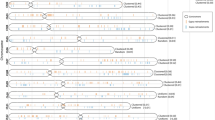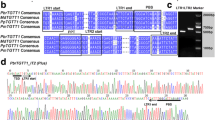Summary
A retrotransposon from the fungal tomato pathogen Cladosporium fulvum (syn. Fulvia fulva) has been isolated and characterised. It is 6968 by in length and bounded by identical long terminal repeats of 427 bp; 5 by target-site duplications were found. Putative first- and second-strand primer binding sites were identified. Three long open reading frames (ORFs) are predicted from the sequence. The first has homology to retroviral gag genes. The second includes sequences homologous to protease, reverse transcriptase, RNAse H and integrase, in that order. Sequence comparisons of the predicted ORFs indicate that this element is closely related to the gypsy class of LTR retrotransposons. Races of the pathogen exhibit polymorphisms in their complement of at least 25 copies of the sequence. Virus-like particles which co-sediment with reverse transcriptase activity were observed in homogenates of the fungus. This is the first report of an LTR retrotransposon in a filamentous fungus.
Similar content being viewed by others
References
Bingham PM, Zachar Z (1989) Retrotransposons and the FB transposon from Drosophila melanogaster. In: Berg DE, Howe MM (eds) Mobile DNA. American Society for Microbiology, Washington DC, pp 485–502
Boeke JD, Corces VG (1989) Transcription and reverse transcription of retrotransposons. Annu Rev Microbiol 43:403–434
Boeke JD (1989) Transposable elements in Saccharomyces cerevisiae. In: Berg DE, Howe MM (eds) Mobile DNA. American Society for Microbiology, Washington DC, pp 403–434
Bozarth RF (1972) A new dimension in microbiology. In: Environmental health perspectives. United States Department of Health Education and Welfare, Washington, pp 23–39
Buck KW (1986) Fungal virology — an overview. In: Buck FW (ed) Fungal virology. CRC Press, Boca Raton, Florida, pp 1–84
Cappello J, Handelsman K, Lodish HF (1985) Sequence of Dictyostelium DIRS-1: An apparent retrotransposon with inverted terminal repeats and internal circle junction. Cell 43:105–115
Clare J, Frabaugh P (1985) Nucleotide sequence of a yeast Ty element: evidence for an unusual mechanism of gene expression. Proc Natl Acad Sci USA 82:2829–2833
Clark DJ, Bilanchone VW, Haywood LJ, Dildine SL, Sandmeyer SB (1988) A yeast sigma composite element Ty3 has properties of a retrotransposon. J Biol Chem 263:1413–1423
Covey SN (1986) Amino acid sequence homology in gag region of reverse transcribing elements and the coat protein of cauliflower mosaic virus. Nucleic Acids Res 14:623–633
de Wit PJGM (1977) A light and scanning-electron microscope study of infection of tomato plants by virulent and avirulent races of Cladosporium fulvum. Neth J Plant Pathol 83:109–122
Dinoor A, Eshed N, Nof E (1988) Puccinia coronata crown rust of oats and grasses. In: Sidhu GS (ed) Advances in plant pathology, vol 6. Academic press, New York, pp 333–344
Doolittle RF, Feng DF, Johnson MS, McClure MA (1989) Origins and the evolutionary relationships of retroviruses. Q Rev Biol 64:1–30
Dunsmuir P, Brorein WJ, Simon MA, Rubin GM (1980) Insertion of the Drosophila transposable element copia generates a 5 base pair duplication. Cell 21:575–579
El-Sherbeini M, Tipper DJ, Mitchell DJ, Bostian KA (1984) Virus-like particle capsid proteins encoded by different L double-stranded RNAs of Saccharomyces cerevisial: their roles in maintenance of M double-stranded killer plasmids. Mol Cell Biol 4:2818–2827
Errede B, Company M, Ferchak JD, Hutchinson CA III (1985) Activation regions in a yeast transposon have homology to mating type control sequences and to mammalian enhancers. Proc Natl Acad Sci USA 82:5423–5427
Fink GR, Boeke JD, Garfinkel DJ (1986) The mechanism and consequences of retrotransposition. Trends Genet 2:118–123
Friesen PD, Nissen MS (1990) Gene organisation and transcription of TED, a lepidopteran retrotransposon integrated within the baculovirus genome. Mol Cell Biol 10:3067–3077
Gardner RC, Howarth AJ, Hahn P, Brown-Leudi M, Shepherd RJ, Messing J (1981) The complete nucleotide sequence of an infectious clone of cauliflower mosaic virus by M13mp7 shotgun sequencing. Nucleic Acids Res. 9:2871–2887
Garfinkel DJ, Boeke JD, Fink GR (1985) Ty element transposition reverse transcriptase and virus-like particles. Cell 42:507–517
Geever RF, Case ME, Tyler BM, Buxton F, Giles NH (1983) Point mutations and DNA rearrangements 5′ to the inducible ga-2 gene of Neurospora allow activator protein-independent transcription. Proc Natl Acad Sci USA 80:7298–7302
Gilliquet V, Legrain M, Hilger F (1987) Sequence of the region 5′ to the negative regulatory gene PHO80 of Saccharomyces cerevisiae. Nucleic Acids Res 15:5893
Goreleva TV, Resnik NL, Schuppe NG (1989) Retrotransposon transposition intermediates are encapsidated into virus-like particles. FEBS Lett 244:307–310
Grandbastien MA, Spielman A, Caboche M (1988) Tnt-1, a mobile retroviral-like element of tobacco isolated by plant cell genetics. Nature 337:376–380
Gurr SJ, Unkles SE, Kinghorn JR (1987) The structure and organisation of nuclear genes of filamentous fungi. In: Kinghorn JR (ed) Gene structure in eukaryotic microbes. IRL Press, Washington, pp 117–127
Hansen LJ, Chalker DL, Sandmeyer SB (1988) Ty3, a yeast retrotransposon associated with tRNA genes has homology to animal retroviruses. Mol Cell Biol 8:5245–5256
Harting R, Kenyon L, Lewis BG, Oliver RP, Turner JG, Coddington A (1988) Conditions for efficient isolation and regeneration of protoplasts from Fulvia fulva. J Phytopathol 122:143–146
Hodgson CP, Fisk RZ (1987) Hybridization probe size control: optimised “oligolabelling”. Nucleic Acid Res 5:6295–6296
Hull R, Sadler J, Longstaff M (1986) The sequence of the Carnation Etched Ring Virus DNA: comparison with cauliflower mosaic virus and retroviruses. EMBO J 5:3083–3090
Inouye S, Yuki S, Saigo K (1986) Complete nucleotide sequence and genome organisation of a Drosophila transposable element 297. Eur J Biochem 154:417–425
Kikuchi Y, Ando Y, Shiba T (1986) Unusual priming mechanism of RNA-directed DNA synthesis in copia retrovirus-like particles of Drosophila. Nature 323:824–826
Kingsman AJ, Kingsman SM (1988) Ty: a retroelement moving forward Cell 53:333–334
Kinsey JA, Helber J (1989) Isolation of a transposable element from Neurospora crassa. Proc Natl Acad Sci USA 86:1929–1933
Kohli J, Munz P, Aebi R, Amstutzt H, Gysler C, Heyer WD, Lehmann L, Schuchert P, Thurianx P, Leupold U, Bell J, Gamulin V, Hottinger H, Pearson D, Soell D (1984) Interallelic and intergeneic conversion in three serine tRNA genes of Schizosaccharomyces pombe. Cold Spring Harbor Symp Quant Biol 49:31–40
Levin HL, Weaver DC, Boeke JD (1990) Two related families of retrotransposans from Schizosaccharomyces pombe. Mol Cell Biol 10:6791–6798
Lindhout P, Korta W, Cislik M, Vos I, Gerlagh T (1989) Further identification of races of Cladosporium fulvum (Fulvia fulva) on tomato originating from the Netherlands, France and Poland. Neth J Plant Pathol 95:43–148
Maniatis T, Fritsch EF, Sambrook J (1982) Molecular cloning: a laboratory manual. Cold Spring Harbor Laboratory Press, Cold Spring Harbor, New York
Marlor R, Parkhurst S, Corces V (1986) The Drosophila melanogaster gypsy transposable element encodes putative gene products homologous to retroviral proteins. Mol Cell Biol 6:1129–1134
McHale MT, Roberts IN, Talbot NJ, Oliver RP (1989) Expression of reverse transcriptase genes in Fulvia fulva. Mol Plant-Microbe Interact 4:165–168
Mellor J, Malim MH, Gull K, Tuite MF, McCready S, Dibbayawan T, Kingsman SM, Kingsman AJ (1985) Reverse transcriptase activity and Ty RNA are associated with virus-like particles in yeast. Nature 318:583–586
Michel F, Lang BF (1985) Mitochondrial class II introns encode proteins related to the reverse transcriptases of retroviruses. Nature 316:641–642
Mount SM, Rubin GM (1985) Complete nucleotide sequence of the Drosophila transposable element copia: homology between copia and retroviral proteins. Mol Cell Biol 5:1630–1638
Norrander J, Kemp T, Messing J (1983) Construction of improved M13 vectors using oligodeoxynucleotide-directed mutagenesis. Gene 26:101–106
Poch O, Sauvaget I, Delarue M, Tordo N (1989) Identification of four conserved motifs among the RNA-dependent polymerase encoding elements. EMBO J 8:3867–3874
Punt PJ, Oliver RP, Dingemanse MA, Pouwels PH, van den Hondel CAMJJ (1987) Transformation of Aspergillus based on the hygromycin B resistance marker from Escherichia coli. Gene 56:117–124
Raeder U, Broda P (1985) Rapid preparation of DNA from filamentous fungi. Lett Appl Microbiol 1:17–20
Ratner L, Haseltine W, Patarca R, Livak KJ, Starciach B, Josephs SF, Doran ER, Rafalski JA, Whitehorn EA, Baumeister K, Ivanoff L, Petteway SR, Pearson ML, Lautenberger JA, Papas TS, Ghrayeb J, Chang NT, Gallo RC, Wong-Stahl F (1985) Complete nucleotide sequence of the AIDS virus, HTLV-III. Nature 313:277–283
Saigo K, Kugimiya W, Matsuo Y, Inouye S, Yoshioka K, Yuki S (1984) The identification of the coding sequence for a reverse transcriptase-like enzyme in a transposable genetic element in Drosophila melanogaster. Nature 312:659–661
Sentry JW, Smyth DR (1989) An element with LTRs and its variant arrangements in the genome of Lilium henryi. Mol Gen Genet 215:349–354
Shiba T, Saigo K (1983) Retreovirus-like particles containing RNA homologous to the transposable element copia in Drosophila melanogaster. Nature 302:119–123
Smyth DR, Kalitsis P, Joseph JL, Sentry JW (1989) A plant retrotransposon from Lilium henryi is related to Ty3 of yeast and the gypsy group of Drosophila. Proc Natl Acad Sci USA 86:5015–5019
Swofford DL (1990) PAUP: Phylogenetic analysis using parsimory. Version 3.0. Computer program distributed by the Illinois Natural History Survey, Champaign, Illinois
Talbot NJ, Coddington A, Oliver RP (1991) Pulsed field gel electrophoresis reveals chromosome length polymorphisms between strains of Cladosporium fulvum (syn. Fulvia fulva). Mol Gen Genet 229:267–272
Tanda S, Shrimpton AE, Ling-Ling C, Itayama H, Matsubayashi K, Saigo K, Tobari YN, Langley CH (1988) Retrovirus-like features and site specific insertions of a transposable element tom in Drosophila ananassae. Mol Gen Genet 214:405–411
van Kan JAL, Van den Ackerveken GFJM, De Wit PJGM (1991) Cloning and characterisation of a cDNA of avirulence gene avr9 of the fungal pathogen C. fulvum; causal agent of tomato leaf mold. Mol Plant Microbe Interact 4:52–60
Voytas DF, Ausubel FM (1988) A copia-like transposable element family in Arabidopsis thaliana. Nature 336:242–244
Weber F, De Villiers J, Schaffner W (1984) An SV40 “enhancer trap” incorporates exogenous enhancers or generates enhancers from its own sequences. Cell 36:983–992
Xiong Y, Eickbush HT (1988) Similarity of reverse transcriptase-like sequences of viruses, transposable elements and mitochondrial introns. Mol Biol Evol 6:675–690
Xu H, Boeke JD (1990) Localisation of sequences required in cis for yeast Tyl element transposition near the long teminal repeats — analysis of mini-Tyl elements. Mol Cell Biol 10:2695–2702
Yuki S, Inouye Y, Ishimaru S, Saigo K (1986) Nucleotide sequence characterisation of a Drosophila retrotransposon 412. Eur J Biochem 158:403–410
Author information
Authors and Affiliations
Additional information
Communicated by D.J. Finnegan
Rights and permissions
About this article
Cite this article
McHale, M.T., Roberts, I.N., Noble, S.M. et al. CfT-I: an LTR-retrotransposon in Cladosporium fulvum, a fungal pathogen of tomato. Molec. Gen. Genet. 233, 337–347 (1992). https://doi.org/10.1007/BF00265429
Received:
Issue Date:
DOI: https://doi.org/10.1007/BF00265429




